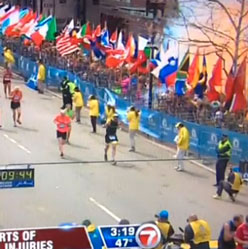May 1, 2013 The FBI is gathering a wide range of video, photographic, text-message and social-media data to stitch together a fuller picture of the April 15 bombing. |
Feds Tackle 'Major Data Crunch' in Boston Investigation By: Frank Konkel, Adam Mazmanian One of the most challenging aspects of the large-scale investigation into the April 15 Boston Marathon bombings is crunching all the incoming data from digital cameras, video, phone calls, text messages, social media and other disparate sources. It's a relatively new challenge for local law enforcement officials and the Federal Bureau of Investigation, which leads the investigation with various federal resources at its disposal. Yet it is a challenge FBI officials have embraced, expressing a desire to collect every bit and byte of potentially useful information to connect the dots. Law enforcement officials have cast a wide net in seeking photo evidence that might yield information about the Boston Marathon bombing, and the FBI has established an e-mail address where eyewitnesses can send photos and videos. Customs officials are reportedly asking travelers departing Boston on international flights to share any photos and videos before they leave the U.S. In short, officials are asking for anything and everything – Boston Police Commission Edward F. Davis stated as much during an April 16 news briefing, pleading with residents that even seemingly insignificant information "might have some value to this investigation." And all that data is a lot to process. "Given that what the FBI has requested is as many photos and images they can possibly get from the event, you're looking at a potential major data crunch," said Bradley Schreiber, vice president of Washington operations for the Applied Science Foundation for Homeland Security. The challenge for law enforcement is to stitch together a visual timeline of events from pre-race setup to the finish line of the Boston Marathon, culling from photos and videos shot by spectators, news footage, and the feeds from a reported 600 surveillance cameras in the vicinity. Added to that data is material posted to Twitter, Instagram, Facebook and YouTube, as well as from other public-facing websites. "Social media is probably the biggest challenges for investigators," Schreiber said. "You can have 1,000 people saying they saw someone in a black or red hood, but are they talking about the same person or someone else? There really aren't algorithms that give you that kind of solution." Since the attacks of 9/11, federal law enforcement has been standing up systems, IT tools and data centers to collect, process and analyze just this kind of information. These systems are well equipped to receive, store and sort through the kind of evidence that bystanders will be submitting, said Van Hitch, former Chief Information Officer at the Justice Department and now a senior advisor at Deloitte Consulting. The FBI is also looking to expand its capacity to analyze images using computer tools. Last January, the FBI put out a call for ideas for a social media mining tool that would give law enforcement a window into emergency situations. In a request for information detailing the FBI's interest in scraping social media for emerging threats and potential crises, the agency said that, "Social media is rivaling 911 services in crisis response and reporting." It is unclear whether such a monitoring dashboard has yet been established by the FBI, but social media monitoring by law enforcement is improving, according to David Petty, vice president of enterprise search firm X1 Discovery. "Candidly, the social media investigative capabilities have come a long way in the last year," Petty told the New York Times in a video interview. "But it's relatively immature when compared to things like computer forensics." In 2013, the FBI plans to stand up improvements to its Next Generation Identification system. It incorporates the ability to match facial recognitions, scars, tattoos and other distinguishing marks with criminal records. Such improvements are expected to reduce matching time "from hours to seconds," according to a recent budget presentation from the federal CIO's office. Counterterrorism specialists have told several publications that existing facial recognition software is being used to compare faces of potential suspects against various drivers' license, visa and passport databases. Advanced as it may be, many photographs and video still require the visual tool we're all most accustomed to using. "It's still going to require a human eye," Schreiber told FCW. "What if the quality of image is poor or you don't even know what you're looking for? A computer is great for comparing images of a person to someone on file, but it's people who have to figure out what we're looking for." Schreiber, a former member of the intelligence community, said the IC "would leverage whatever resources it can" to the investigation as well, and said data storage and sharing of information between agencies isn't likely to be a problem, either. "In the course of a national investigation, you're not going to have problems anymore like we did in 9/11," Schreiber said, referring to stovepipe models of data storage and sharing popular a decade ago. "Those problems have certainly been addressed since then," he added. Frank Konkel is a staff writer covering big data, mobile, open government and a range of science/technology issues. Connect with him on Twitter at @Frank_Konkel. Adam Mazmanian is a staff writer covering Congress, the FCC and other key agencies. Connect with him on Twitter: @thisismaz. |

